Page 26 of 506
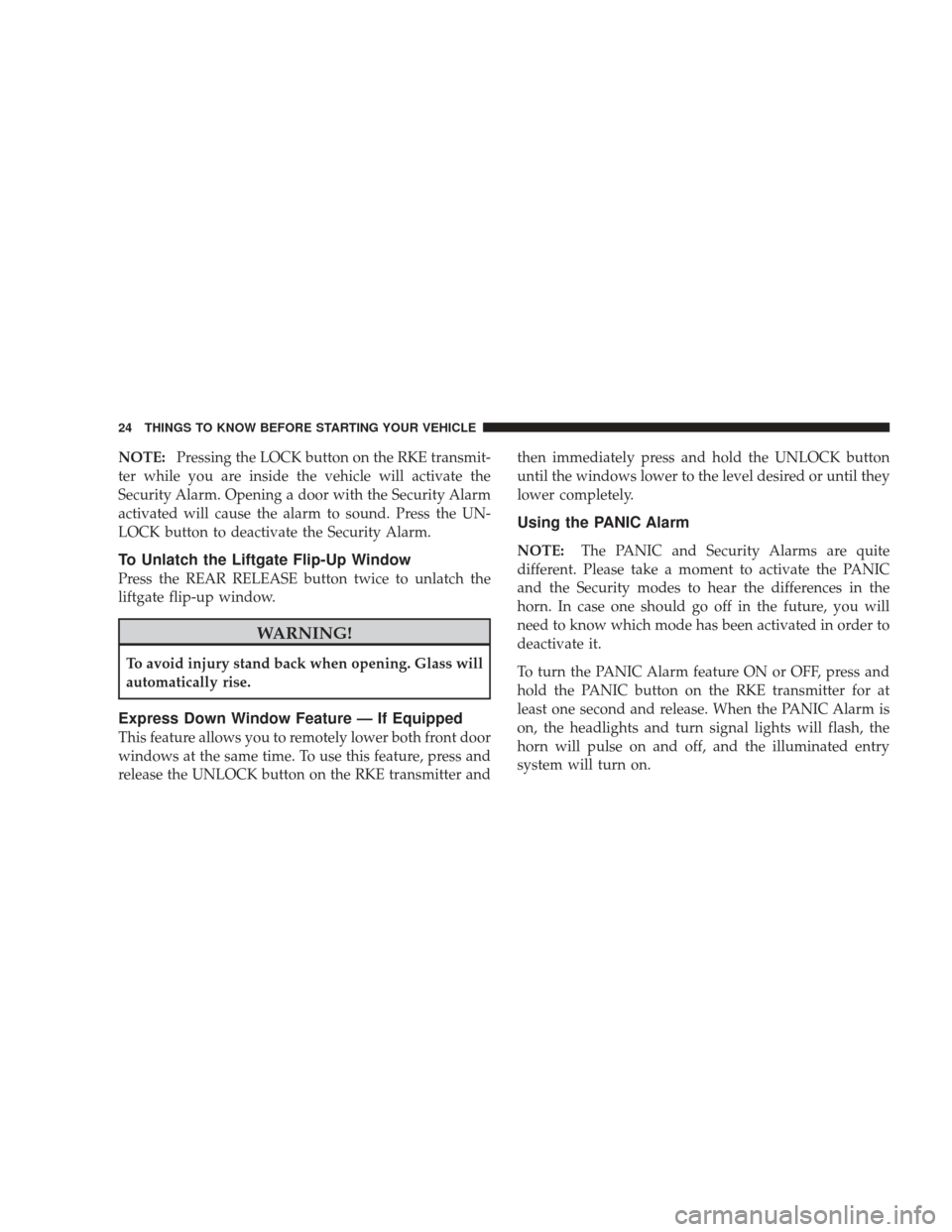
NOTE:Pressing the LOCK button on the RKE transmit-
ter while you are inside the vehicle will activate the
Security Alarm. Opening a door with the Security Alarm
activated will cause the alarm to sound. Press the UN-
LOCK button to deactivate the Security Alarm.
To Unlatch the Liftgate Flip-Up Window
Press the REAR RELEASE button twice to unlatch the
liftgate flip-up window.
WARNING!
To avoid injury stand back when opening. Glass will
automatically rise.
Express Down Window Feature — If Equipped
This feature allows you to remotely lower both front door
windows at the same time. To use this feature, press and
release the UNLOCK button on the RKE transmitter and then immediately press and hold the UNLOCK button
until the windows lower to the level desired or until they
lower completely.
Using the PANIC Alarm
NOTE:
The PANIC and Security Alarms are quite
different. Please take a moment to activate the PANIC
and the Security modes to hear the differences in the
horn. In case one should go off in the future, you will
need to know which mode has been activated in order to
deactivate it.
To turn the PANIC Alarm feature ON or OFF, press and
hold the PANIC button on the RKE transmitter for at
least one second and release. When the PANIC Alarm is
on, the headlights and turn signal lights will flash, the
horn will pulse on and off, and the illuminated entry
system will turn on.
24 THINGS TO KNOW BEFORE STARTING YOUR VEHICLE
Page 27 of 506

The PANIC Alarm will stay on for three minutes unless
you turn it off by pressing the PANIC button a second
time or if the vehicle speed is 5 mph (8 km/h) or greater.
During the PANIC Mode, the door locks and Remote
Keyless Entry (RKE) system will function normally.
PANIC mode will not disarm the Security System on
vehicles so equipped.
NOTE:You may need to be close to the vehicle when
using the RKE transmitter to turn off the PANIC Alarm
due to the radio frequency noises emitted by the system.
Programming Additional Transmitters
Refer to Sentry Key� “Customer Key Programming.”
If you do not have a programmed RKE transmitter,
contact your authorized dealer for details.
Battery Replacement
The recommended replacement battery is CR2032.
NOTE:
•Perchlorate Material — special handling may apply.
See www.dtsc.ca.gov/hazardouswaste/perchlorate.
•Do not touch the battery terminals that are on the back
housing or the printed circuit board.
1. Remove the screw from the RKE transmitter case (if
equipped).
THINGS TO KNOW BEFORE STARTING YOUR VEHICLE 25
2
Page 29 of 506
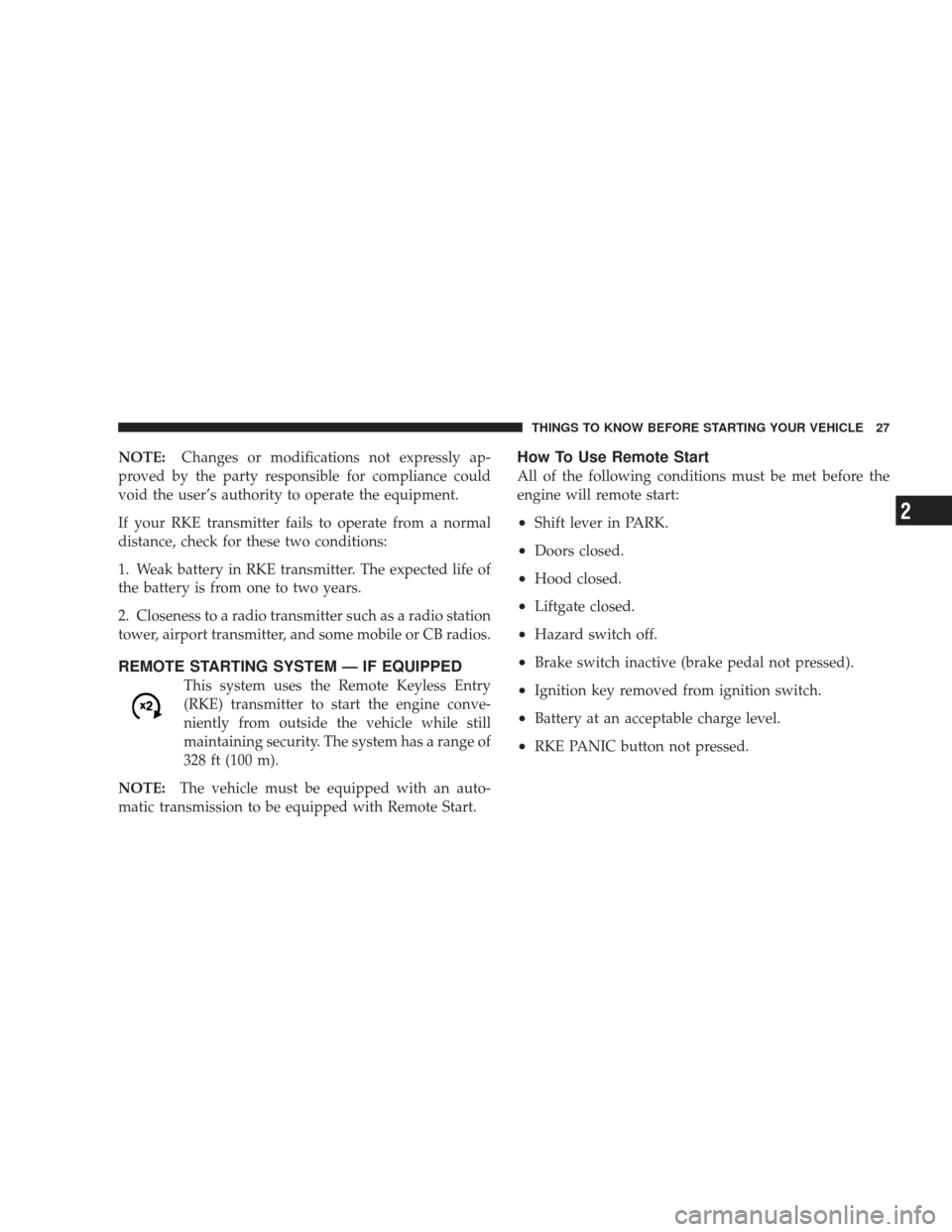
NOTE:Changes or modifications not expressly ap-
proved by the party responsible for compliance could
void the user’s authority to operate the equipment.
If your RKE transmitter fails to operate from a normal
distance, check for these two conditions:
1. Weak battery in RKE transmitter. The expected life of
the battery is from one to two years.
2. Closeness to a radio transmitter such as a radio station
tower, airport transmitter, and some mobile or CB radios.
REMOTE STARTING SYSTEM — IF EQUIPPED
This system uses the Remote Keyless Entry
(RKE) transmitter to start the engine conve-
niently from outside the vehicle while still
maintaining security. The system has a range of
328 ft (100 m).
NOTE: The vehicle must be equipped with an auto-
matic transmission to be equipped with Remote Start.
How To Use Remote Start
All of the following conditions must be met before the
engine will remote start:
•Shift lever in PARK.
•Doors closed.
•Hood closed.
•Liftgate closed.
•Hazard switch off.
•Brake switch inactive (brake pedal not pressed).
•Ignition key removed from ignition switch.
•Battery at an acceptable charge level.
•RKE PANIC button not pressed.
THINGS TO KNOW BEFORE STARTING YOUR VEHICLE 27
2
Page 30 of 506

To Enter Remote Start Mode
Press and release the REMOTE START button
on the RKE transmitter twice, within five sec-
onds. The parking lights will flash and the horn
will chirp twice (if programmed). Then, the
engine will start and the vehicle will remain in the
Remote Start mode for a 15-minute cycle.
NOTE:
•For security, power window operation and sunroof or
Sky Slider� operation (if equipped) is disabled when
the vehicle is in the Remote Start mode.
•The engine can be started two consecutive times (two
15-minute cycles) with the RKE transmitter. However,
the ignition switch must be cycled to the ON position
before you can repeat the start sequence for a third
cycle.
To Exit Remote Start Mode without Driving the
Vehicle
Press and release the REMOTE START button one time or
allow the engine to run for the entire 15-minute cycle.
NOTE: To avoid unintentional shut downs, the system
will disable the one-time press of the REMOTE START
button for two seconds after receiving a valid Remote
Start request.
To Exit Remote Start Mode and Drive the Vehicle
Before the end of the 15-minute cycle, press and release
the UNLOCK button on the RKE transmitter to unlock
the doors and disarm the Vehicle Security Alarm (if
equipped). Then, insert the key into the ignition switch
and turn the switch to the ON position.
NOTE: The ignition switch must be in the ON position
in order to drive the vehicle.
28 THINGS TO KNOW BEFORE STARTING YOUR VEHICLE
Page 31 of 506
DOOR LOCKS
Manual Door Locks
To lock each door, push the door lock plunger on each
door trim panel downward. To unlock each door, pull the
door lock plunger on each door trim panel upward.If the door lock plunger is down when you shut the door,
the door will lock. Make sure the keys are not inside the
vehicle before closing the door.
NOTE:
The manual door locks will not lock or unlock
the liftgate.
WARNING!
•For personal security and safety in the event of an
accident, lock the vehicle doors as you drive as
well as when you park and leave the vehicle.
•When leaving the vehicle, always remove the key
from the ignition lock, and lock your vehicle.
Unsupervised use of vehicle equipment may cause
severe personal injuries and death.
(Continued)
Manual Lock Plunger
THINGS TO KNOW BEFORE STARTING YOUR VEHICLE 29
2
Page 58 of 506
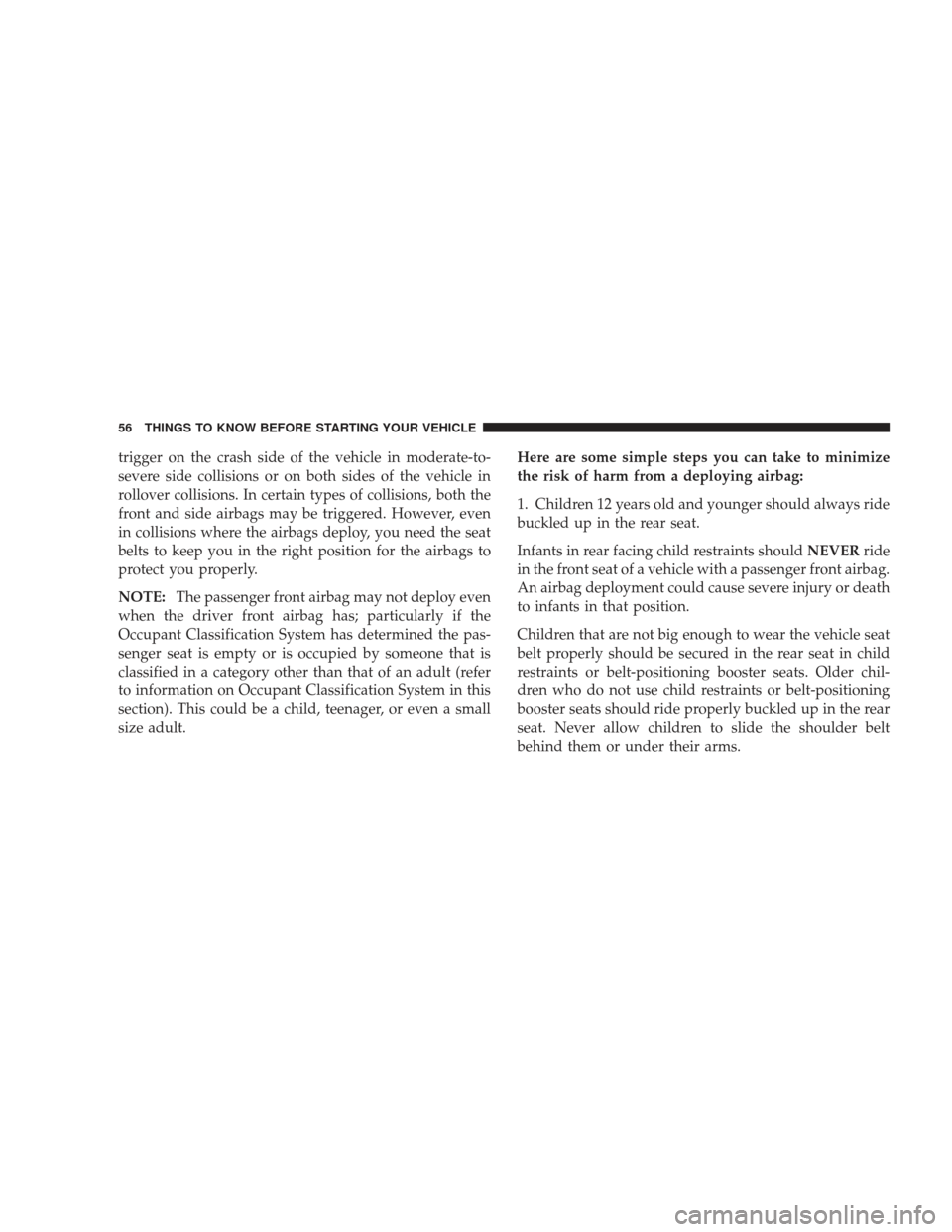
trigger on the crash side of the vehicle in moderate-to-
severe side collisions or on both sides of the vehicle in
rollover collisions. In certain types of collisions, both the
front and side airbags may be triggered. However, even
in collisions where the airbags deploy, you need the seat
belts to keep you in the right position for the airbags to
protect you properly.
NOTE:The passenger front airbag may not deploy even
when the driver front airbag has; particularly if the
Occupant Classification System has determined the pas-
senger seat is empty or is occupied by someone that is
classified in a category other than that of an adult (refer
to information on Occupant Classification System in this
section). This could be a child, teenager, or even a small
size adult. Here are some simple steps you can take to minimize
the risk of harm from a deploying airbag:
1. Children 12 years old and younger should always ride
buckled up in the rear seat.
Infants in rear facing child restraints should
NEVERride
in the front seat of a vehicle with a passenger front airbag.
An airbag deployment could cause severe injury or death
to infants in that position.
Children that are not big enough to wear the vehicle seat
belt properly should be secured in the rear seat in child
restraints or belt-positioning booster seats. Older chil-
dren who do not use child restraints or belt-positioning
booster seats should ride properly buckled up in the rear
seat. Never allow children to slide the shoulder belt
behind them or under their arms.
56 THINGS TO KNOW BEFORE STARTING YOUR VEHICLE
Page 59 of 506
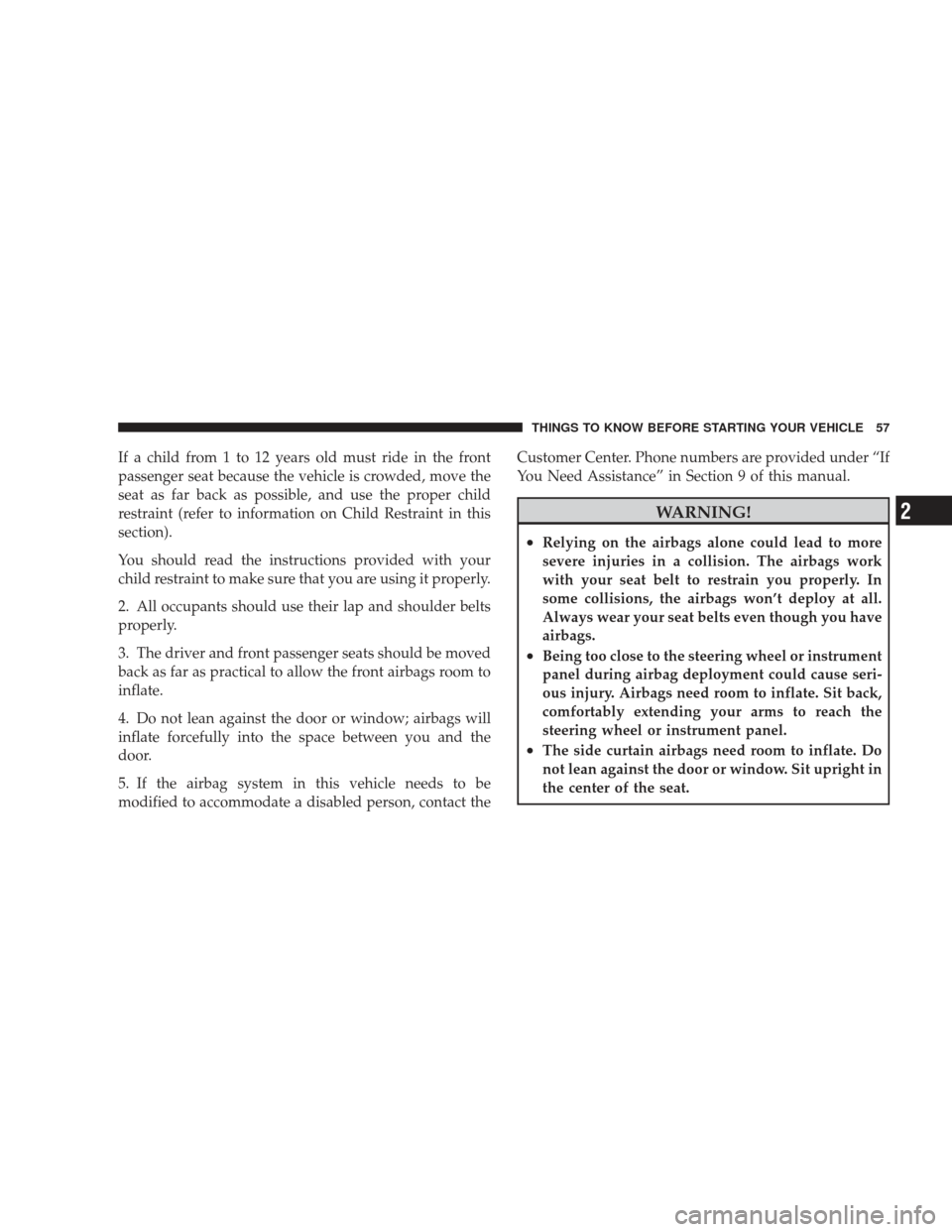
If a child from 1 to 12 years old must ride in the front
passenger seat because the vehicle is crowded, move the
seat as far back as possible, and use the proper child
restraint (refer to information on Child Restraint in this
section).
You should read the instructions provided with your
child restraint to make sure that you are using it properly.
2. All occupants should use their lap and shoulder belts
properly.
3. The driver and front passenger seats should be moved
back as far as practical to allow the front airbags room to
inflate.
4. Do not lean against the door or window; airbags will
inflate forcefully into the space between you and the
door.
5. If the airbag system in this vehicle needs to be
modified to accommodate a disabled person, contact theCustomer Center. Phone numbers are provided under “If
You Need Assistance” in Section 9 of this manual.
WARNING!
•Relying on the airbags alone could lead to more
severe injuries in a collision. The airbags work
with your seat belt to restrain you properly. In
some collisions, the airbags won’t deploy at all.
Always wear your seat belts even though you have
airbags.
•Being too close to the steering wheel or instrument
panel during airbag deployment could cause seri-
ous injury. Airbags need room to inflate. Sit back,
comfortably extending your arms to reach the
steering wheel or instrument panel.
•The side curtain airbags need room to inflate. Do
not lean against the door or window. Sit upright in
the center of the seat.
THINGS TO KNOW BEFORE STARTING YOUR VEHICLE 57
2
Page 73 of 506
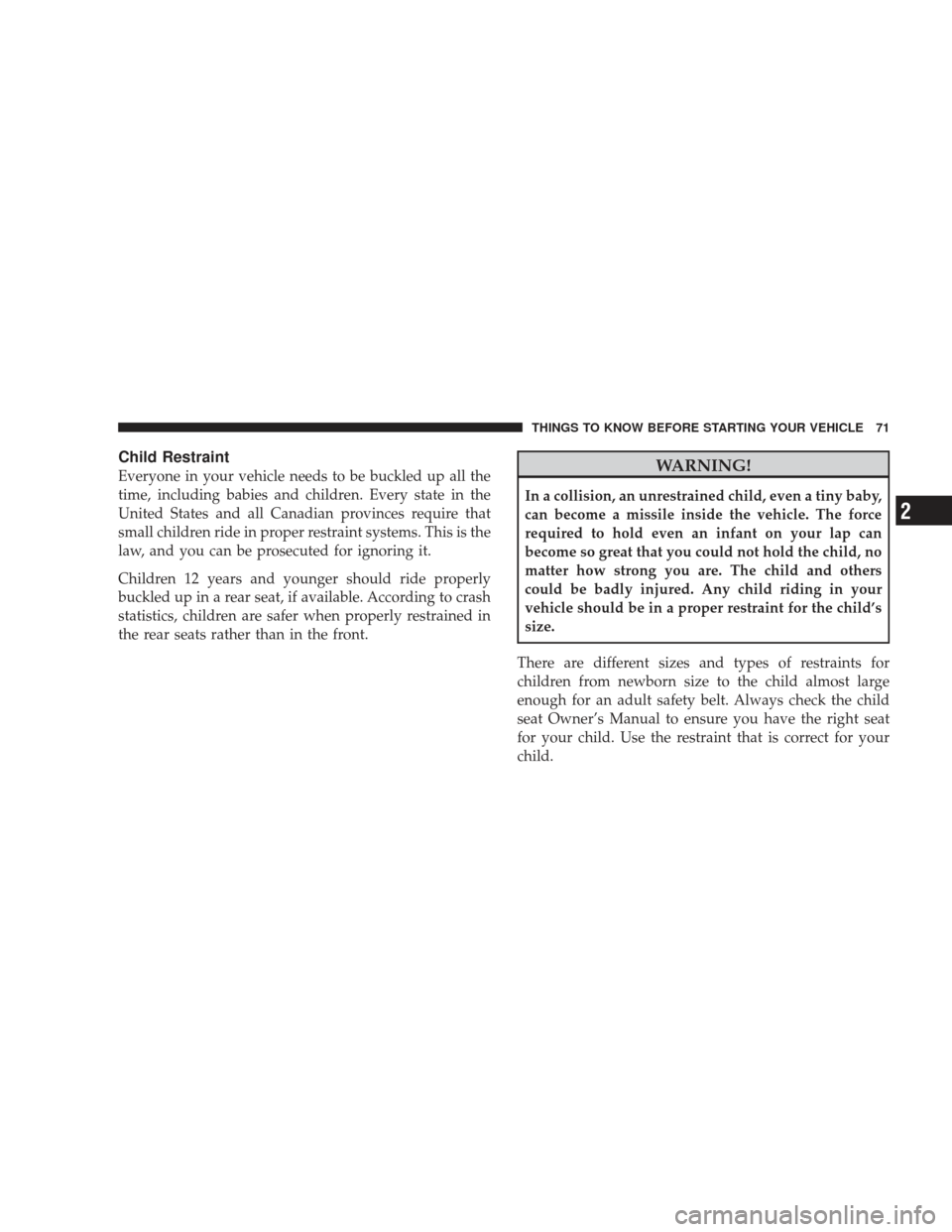
Child Restraint
Everyone in your vehicle needs to be buckled up all the
time, including babies and children. Every state in the
United States and all Canadian provinces require that
small children ride in proper restraint systems. This is the
law, and you can be prosecuted for ignoring it.
Children 12 years and younger should ride properly
buckled up in a rear seat, if available. According to crash
statistics, children are safer when properly restrained in
the rear seats rather than in the front.WARNING!
In a collision, an unrestrained child, even a tiny baby,
can become a missile inside the vehicle. The force
required to hold even an infant on your lap can
become so great that you could not hold the child, no
matter how strong you are. The child and others
could be badly injured. Any child riding in your
vehicle should be in a proper restraint for the child’s
size.
There are different sizes and types of restraints for
children from newborn size to the child almost large
enough for an adult safety belt. Always check the child
seat Owner’s Manual to ensure you have the right seat
for your child. Use the restraint that is correct for your
child.
THINGS TO KNOW BEFORE STARTING YOUR VEHICLE 71
2